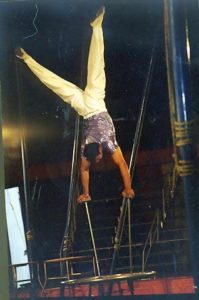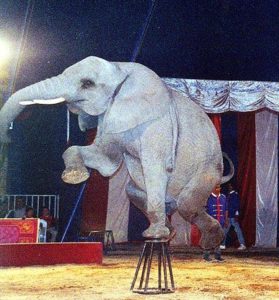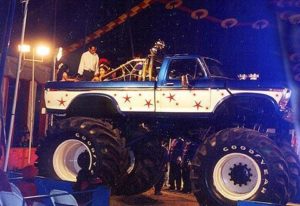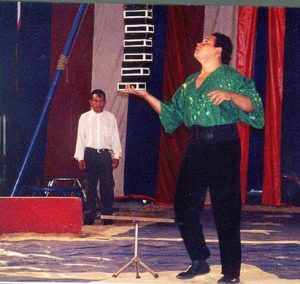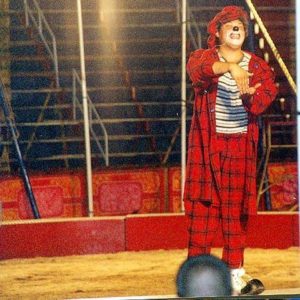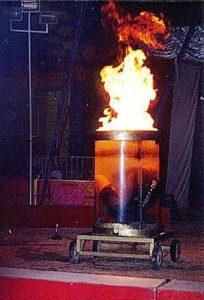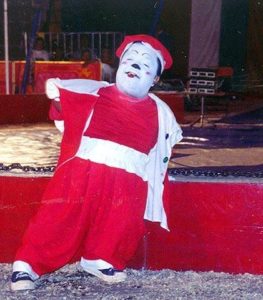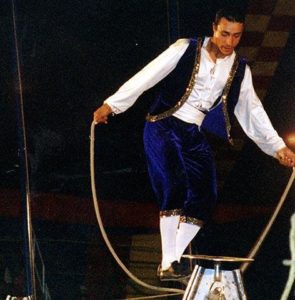Israel Gonzalez, of the circus family known as the Kaylicoas, is the tightrope walker of the Vazquez Hermanos Circus. He also performs an act of gymnastics, balancing on alternating hands, and breezes through a number of other physically demanding stunts. A third act involves his submersing himself under water in a glass cylinder holding his breath while gasoline is poured on top of the water above him and set on fire. He states that the exact same quantity of gasoline is used for every performance so he can time how long it takes for the fire to go out. When he performs in Mexicali, which is a bit below sea-level, he says he can hold his breath much longer, once over 3 minutes. Morelia, over 6,000 feet above sea level, makes it much harder. For this stunt he gets top billing as “The Human Volcano” in the circus advertisements. In each of his three performances he wears a different costume. He moves through his acts with a calm determination.
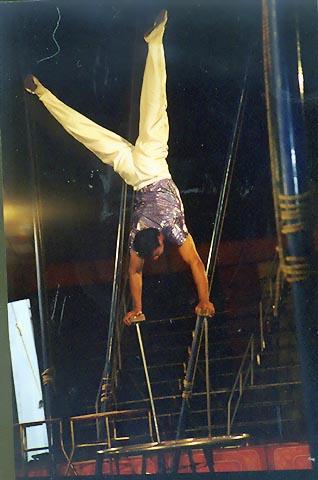
The tight rope is not a high one. It is approximately twelve feet above the dirt floor of the circus ring. Israel uses no safety strap or net. He wears a loose-fitting purple-velvet waistcoat and knickers with gold filigree borders, a cream-colored mid-eastern shirt with a Nehru-type collar, long white socks, and ballet slippers. As he skims along the wire, his head and neck remain rigidly aligned vertically in contrast to the sinuous side-to-side adjustments of the rest of his body.
One marvels at the apparent ease with which he moves through his demanding physical routine. An assistant on the ground holds up a banner in front of Israel as a barrier across his path as high as his waist. He jumps over it landing back on the wire. He appears to struggle for a moment with his balance. On recovery, he reaches the pedestal platform at the end of the tight wire, turns to the loudly cheering audience and smiles engagingly with a shake of his head as if to say ” Boy, that was a close call!”
The Vazquez Brothers Circus is a mixture of American and Mexican styles. According to the manager, one of the owners, who grew up in the circus, the big top tent is of the American travelling-circus style, a type that can be put up and taken down quickly. It is tremendous and easily houses the three performance rings When it arrives in town, the circus can be set up in six hours flat. At departure time, they need only two hours to dismantle everything and be back on the road. One of the attractions, proudly proclaimed on signs advertising the circus, is the “giant Texas Armadillo”.
After seeing the circus for the first time, I asked the owner where the armadillo was, since I failed to see one during the show. After getting over his fit of laughter, he corrected me…it was the big pick-up truck with the giant tires with Texas plates, not an animal. So much for gringo smarts! The owners feel that the excitement of the three ring American circuses adds flavor to the ambience and so have compromised. Whereas most Mexican circuses feature only one ring, Vazquez Hermanos features three rings. However some of the acts are presented simultaneously, one in each ring, whereas others go on in one ring with the other rings empty.
The Vazquez Hermanos circus is one of more than 80 Mexican circuses. In my first meeting with the owner who is one of the Vazquez brothers, I introduced myself as a “gringo”. He laughed and said he was also commonly labelled by an analogous term, “cirquero”, meaning someone who works in and travels with the circus. Like the term “gringo”, it is often used in a demeaning sense. However he and his family are proud of the label. He was born into the circus as was his father and his grandfather before him.
Like many other Mexican circuses, this one was born on a ranch in a rural area of Mexico as a sort of rodeo. It was a way of raising money to sustain the family during hard times and allowed people the chance to take their minds off their problems for a while. During the early 1900’s through the parallel development of the Mexican revolution, the circus slowly evolved, based on knowledge of what American and European circuses were doing. In those early days, running a circus was a dangerous enterprise because Mexicans carried loaded guns and law enforcement was sporadic.
Annual route
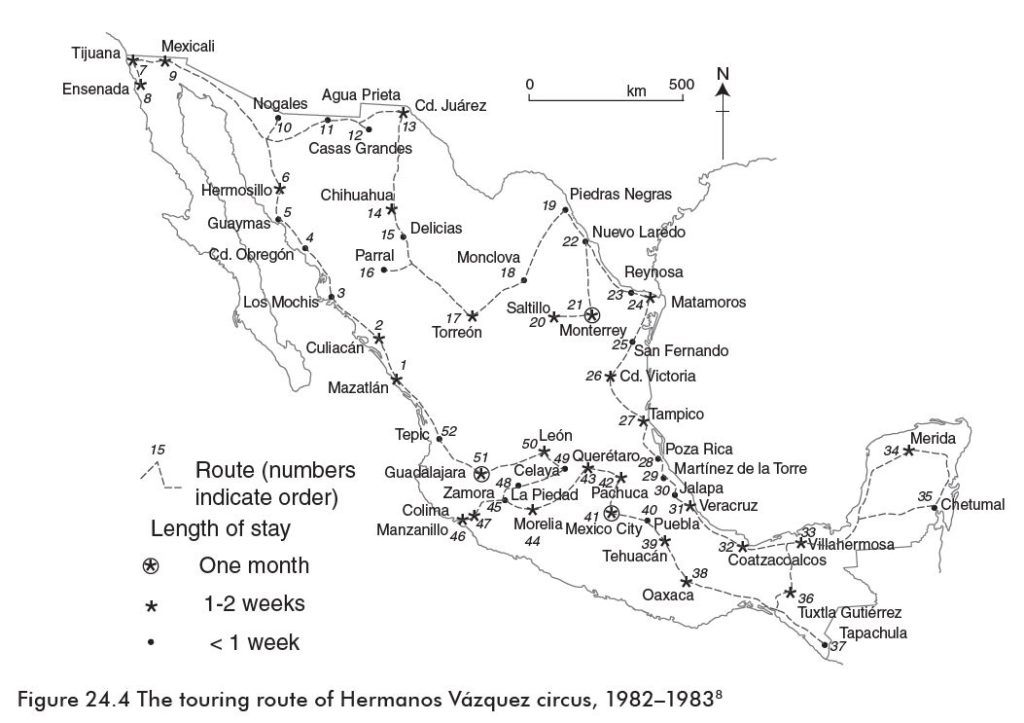
Now, management requires a much more modern approach. The circus travels around Mexico in a two year circuit. Advance planning requires a study of the demographics of the land, and an intimate knowledge of local laws and customs. Permits for each locality are required in advance. For largely populated areas such as Guadalajara, Morelia, Monterrey, and Mexico City, the permits may have to be applied for as much as three months in advance because there is a lot of competition for a limited number of permits.
If a permit to one of these “remunerative” areas is denied, the circus may apply to a small town outside of the “metropolis” for a few days, reapplying for a different time slot in the big city. They then open the circus in the small town and wait for their time slot to open in the big city. Mr. Vazquez’ father advises the brothers on the circus’s travelling schedule because he is the most knowledgeable about Mexico’s towns and cities.
The father still lives and travels with the circus, along with his wife, Mr. Vazquez’ mother. He was a lion tamer with the circus during his early years. He performed a wild-animal act dressed as an “American-style” cowboy, with cowboy boots, a cowboy hat and twin holstered six guns. He was billed as the “Sheriff of Yuma”. His son says he carried this off well because he always looked like a “gringo”. In his 70’s, he has clear deep-blue eyes, light skin and silver gray hair. He walks slowly, but proudly erect. His slow speech and paucity of facial expression are suggestive of Parkinson’s Disease.
Mrs. Vazquez can be seen sitting in the big top during performances. She seems to be the “circus mother”. Many of the performers and vendors stop to chat with her.The senior Mr. Vazquez comes in to sit with her for a time and directs the driver of the monster truck, the “Texas Armadillo”, with waves of his arms.
For these people of the circus, the “cirqueros”, home is where the circus is. They are never comfortable when away from it. The owner told me with some amusement that when he hires acts from other countries, the performers occasionally elect to stay in hotels. Those from circus families prefer to live with the circus. His wife is not from a circus family. When his children, who were also born into the circus, take short trips away from the circus with his wife, they usually call him within a few days to tell him they want to return “home”.
Circus performers find that one of the negative aspects of circus life is not having their families together. The families tend to segment when sisters and brothers get married and start families of their own, often going on to non-circus activities in other places. In the last few years, through political lobbying, the Mexican government was motivated to pass laws allowing an educational certificate obtained via ‘on-the-road’ learning such as with the circus to be accepted as valid. The Vazquez brothers hired a teacher from Tijuana who travels with the circus and gives classes to all the school-age children of the performers and workers..
The Vazquez Hermanos Circus employs 63 people including 17 performers. Between 20 – 24 extras are hired in each location to help set-up and break-down the circus. They have 8 tractor trailers. All performers and regular workers live in their own trailers. For those who don’t want to eat at restaurants or fast-food places, a woman hired by the circus prepares simple, inexpensive meals three times a day. She travels with the circus.
The owner tells me it is a long-standing circus tradition to pitch in and assist. They call this “echando la paloma”. If a circus person is unable to do his or her job, someone else fills in. Many of the performers can be seen doing jobs other than those they were contracted for. The owner’s daughter was working one of the spotlights after her juggling and hula-hoop act the night I saw the circus. One of the clowns, who also does a creditable juggling act, was selling trinkets during the intermission. I was surprised one night to see Mr. Vazquez himself standing just outside of the center ring holding a microphone.Acting as the announcer, he was dressed in a circus jacket and brightly colored cap
As a young boy he sometimes filled in playing in the circus’ band because he knew how to play the trumpet. Sadly, he related, it is no longer cost effective to have a live circus band so recorded tapes and a speaker system are relied on.
The circus has 6 clowns. Marco Antonio, an engaging 35 year old dwarf, has been working as a circus clown for over 20 years. Born in Puebla, he was working in a video store where Mr. Vazquez, the owner of the circus, spotted him and asked if he might be interested in circus work. One look at the circus convinced Marco Antonio that this would be his future. He has never regretted his decision.
One of the clown acts involves the clown who also juggles. The announcer asks all kids in the audience to come foreward. The clown lines them up in the ring and plays a “Simon Says” type game with them. Each time a child makes a mistake, the clown acts upset and feigns an attempt to swat him with a paddle, which, of course he never does. The child runs out of the ring urged on by the announcer, returning to his parents to applause and laughter. The crowd thrives on this.The remaining child who hasn’t made a mistake is presented with a can of soda and a bag of chips by the clown.
In another clown bit, the same clown does a pantomime using a whistle to organize the audience into 2 competing applause groups. It is totally endearing and gets the audience laughing uproariously. I had no difficulty understanding the non-verbal communication of the clown. I was reminded of the oft-quoted axiom of the universal language that breaches geographical, racial and language barriers
During the intermission, as in many Mexican circuses, the children are the center of attention. They are called out into center ring, boosted up on top of the elephant and have their pictures taken. They are also given a ride on the “Texas Armadillo”. Several of the circus performers, including Israel Gonzalez, help in lifting kids up into the back of the monster pick-up truck.
Israel Gonzalez, 28 years old, has his own trailer, in which he lives with his wife and 6 month old daughter. He is the 5th generation of a circus family that originated in Haiti. He is a handsome, engaging young man. His appearance when dressed in his “street” clothes belies the powerful, athletic image one sees during his “human volcano” and gymnastics acts. Perhaps most impressive is the unassuming air he projects when not performing; he seems totally unaware of his considerable talents and his importance to the circus.
He smilingly told me his great-grandfather was “very black” whereas he has typical “tan” Latin skin color. He has performed in circuses in several European and Latin American countries since becoming adept at his performing skills at the age of 6, most of them taught to him by his parents and other family members who were also circus performers. His father won a gold medal in the famous world circus competition in Monte Carlo years ago. He avers that his love of the circus comes from being able to see and experience many parts of the world.
He expresses his pleasure at participating in the interview because it might help promote greater understanding of what circus people and circuses are all about. He says that circus performers are widely believed to be unclean and dishonest; that they live lives of decadence and sin. He states that circus work is like any other job. When he is working, he gives it his full attention and effort. When the performance is over, he lives like any average person. His warm smile, gentle speech and well thought-out ideas were stirring counterpoints to his persona while performing…amazing strength underlying near-perfect balance and poise. The owner tells me that Israel is a circus owners dream, a multi-talented performer who is willing to do anything to help the circus.
During Israel’s gymnastics performance, he shares the “stage” with 2 other acts, each in a different ring. In this act, he wears a tight fitting shirt with short sleeves and standard men’s gymnastics slacks. His powerful arm and shoulder muscles ripple as he effortlessly performs, alternatingly balancing on one arm at a time, then on his head. His control and equilibrium are awe-inspiring. I have not seen better in any circus or athletic event.
The circus travels with a bevy of animals, including a Bengal tiger, an elephant, 2 hippos, a camel, several llamas, a Clydesdale horse and a monkey. The owner’s brother, Pablo Vazquez, is the animal trainer. He does the tiger act with a healthy-looking tiger on a leash without a cage around him and gets the animal to jump through a flaming hoop.
One of the clowns, an achondroplastic dwarf named Marco Antonio, does an act with a hippo. The hippo is gently herded around and then into one of the rings. Two assistants walk on either side of the massive creature each carrying what looks like a segment of steel railing. Apparently, this makes the animal think he is still in his cage and deters him from wanting to run into the audience. The ungainly waddle of Marco Antonio, the dwarf, harmonizes with that of the hippo. His gentle treatment of the lumbering animal bespeaks an empathy for another living creature who failed to receive some of the finer attributes of the animal kingdom at birth. The hippo gets up on a small table, then gets off the table and lays his head upon it at the insistence of the clown.
Mr. Vazquez is aware of all the laws severely restricting the use of animals by circuses in the U.S. and Europe and posits that such restrictions may soon come to Mexico. He is not looking forward to this day because he feels animals have always been an integral part of the circus. The circus has already been exposed to demonstrations by “animal rights activists” in some of the big Mexican cities. He feels that the only way circus owners can stave off laws that make it impossible for them to continue to feature animals is by demanding that cock fights, bull fights and dog fights be also outlawed. “Circus people love their animals because the animals give them so much”, he says.
His brother, Pablo, is from the school of wild animal trainers that decries hitting or hurting animals to teach them tricks.A few years ago, one of their tigers became ill and died while they were on the road. Afraid if they buried it with a grave marker it would be dug up for souvenirs such as teeth and ears, they left out the marker.
The circus has an on-going arrangement with the Queretaro Zoo. When animals become too old to travel, they are placed with the zoo. Conversely, from time to time, the zoo donates or sells young animals to the circus when the population of a particular breed is more than the zoo’s requirement.
Two days earlier, I attended the circus as a spectator and the previous evening I had the pleasure of interviewing some of the circus’ performers. I arrived early before the 6:15 P.M. performance to line up positions for taking photos of the various acts. A crowd of spectators had entered the big top and many were already seated. Several vendors were strolling through the area hawking wares including games, edibles and souvenirs.
Out of the corner of my eye, I spotted a familiar face. It was one of the vendors in a typical circus vendors outfit with a colorful cap selling bags of popcorn. As he weaved through lines of circus-goers heading for their seats, then with his back to me, I followed him trying to see who he was. He suddenly stopped and turned toward me. A look of recognition came over his face. It was Israel Gonzalez, the “Human Volcano”, premier performer of the Vazquez Hermanos Circus. He smiled at me brightly and gave me the thumbs-up sign which said to my surprised face that it was O.K., that this was a part of his contribution too. Humility and humanity, hallmarks of the Mexican circus. It was a while before the tears in my eyes dried.

